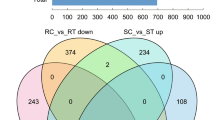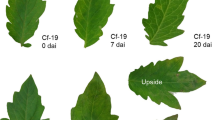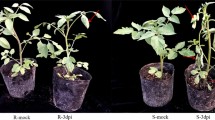Abstract
Key message
Based on the physiological and RNA-seq analysis, some progress has been made in elucidating the Cf-10-mediated resistance responses to C. fulvum infection in tomato. GO and KEGG enrichment analysis revealed that the DEGs were significantly associated with defense-signaling pathways like oxidation-reduction processes, oxidoreductase activity and plant hormone signal transduction.
Abstract
Leaf mold, caused by the fungus Cladosporium fulvum, is one of the most common diseases affecting tomatoes worldwide. Cf series genes including Cf-2, Cf-4, Cf-5, Cf-9 and Cf-10 play very important roles in resisting tomato leaf mold. Understanding the molecular mechanism of Cf gene-mediated resistance is thus the key to facilitating genetic engineering of resistance to C. fulvum infection. Progress has been made in elucidating two Cf genes, Cf -19 and Cf -12, and how they mediate resistance responses to C. fulvum infection in tomato. However, the mechanism of the Cf-10- mediated resistance response is still unclear. In the present study, RNA-seq was used to analyze changes in the transcriptome at different stages of C. fulvum infection. A total of 2,242 differentially expressed genes (DEGs) responsive to C. fulvum between 0 and 16 days post infection (dpi) were identified, including 1,501 upregulated and 741 downregulated genes. The majority of DEGs were associated with defense-signaling pathways including oxidation–reduction processes, oxidoreductase activity and plant hormone signal transduction. Four DEGs associated with plant-pathogen interaction were uniquely activated in Cf-10 tomato and validated by qRT-PCR. In addition, physiological indicators including reactive oxygen species (ROS), superoxide dismutase (SOD), catalase (CAT) and peroxidase (POD) were measured at 0–21 dpi, and hormone expression [Jasmonic acid (JA) and salicylic acid (SA)] was estimated at 0 and 16 dpi to elucidate the mechanism of the Cf-10-mediated resistance response. C. fulvum infection induced the activities of POD, CAT and SOD, and decreased ROS levels. JA was determined to participate in the resistance response to C. fulvum during the initial infection period. The results of this study provide accountable evidence for the physiological and transcriptional regulation of the Cf-10-mediated resistance response to C. fulvum infection, facilitating further understanding of the molecular mechanism of Cf-10-mediated resistance to C. fulvum infection.








Similar content being viewed by others
References
Abdel-Ghany SE, Hamilton M, Jacobi JL et al (2016) A survey of the sorghum transcriptome using single-molecule long reads. Nature Commun 7:11706. https://doi.org/10.1038/ncomms11706
Anders S, Huber W (2010) Differential expression analysis for sequence count data. Genome Biol 11:R106. https://doi.org/10.1186/gb-2010-11-10-r106
Balint-Kurti PJ, Dixon MS, Jones DA et al (1994) RFLP linkage analysis of the cf-4 and cf-9 genes for resistance to Cladosporium fulvum in tomato. Theor Appl Genet 88:691–700. https://doi.org/10.1007/BF01253972
Benjamini Y, Hochberg Y (1995). Controlling the false discovery rate: a practical and powerful approach to multiple testing. J R Stat Soc B 57:289–300
Bhattarai K, Louws FJ, Williamson JD et al (2016) Diversity analysis of tomato genotypes based on morphological traits with commercial breeding significance for fresh market production in eastern USA. Aust J Crop Sci 10(8):1098. https://doi.org/10.21475/ajcs.2016.10.08.p7391
Bolton MD, Vossen JH, Stulemeijer IJE et al (2007) Proteomic analysis of the apoplast of Cladosporium fulvum-infected tomato reveals novel virulence factors. Book of Abstracts XIII International Congress on Molecular Plant-Microbe Interactions, Sorrento, Italy, pp 271–271
Cai G, Wang G, Wang L et al (2014) ZmMKK1, a novel group A mitogen-activated protein kinase kinase gene in maize, conferred chilling stress tolerance and was involved in pathogen defense in transgenic tobacco. Plant Sci 214:57–73. https://doi.org/10.1111/j.1365-3040.2011.02329.x
Chakrabarti A, Velusamy T, Tee CY, Jones DA (2016) A mutational analysis of the cytosolic domain of the tomato cf-9 disease-resistance protein shows that membrane-proximal residues are important for avr9-dependent necrosis. Mol Plant Pathol 17:565–576. https://doi.org/10.1111/mpp.12315
De Wit PJGM. (1977) A light and scanning-electron microscopic study of infection of tomato plants by virulent and avirulent races of Cladosporium fulvum. Neth J Plant Pathol 83:109–122. https://doi.org/10.1007/BF01981556
De Wit PJGM. (1994) Host resistance to a fungal tomato pathogen lost by a single base-pair change in an avirulence gene. Nature 367:384–386. https://doi.org/10.1038/367384a0
De Jong CF, Honee GUY, Joosten MHAJ. et al (2000) Early defence responses induced by AVR9 and mutant analogues in tobacco cell suspensions expressing the cf-9 resistance gene. Physiol Mol Plant Pathol 56:169–177. https://doi.org/10.1006/pmpp.2000.0263
Dhindsa RS, Plumb-Dhindsa P, Thorpe TA (1981) Leaf senescence: correlated with increased levels of membrane permeability and lipid peroxidation, and decreased levels of superoxide dismutase and catalase. J Exp Bot 32:93–101. https://doi.org/10.1093/jxb/32.1.93
Dixon MS, Jones DA, Keddie JS et al (1996) The tomato cf-2 disease resistance locus comprises two functional genes encoding leucine-rich repeat proteins. Cell 84:451–459. https://doi.org/10.1016/S0092-8674(00)81290-8
Dixon MS, Hatzixanthis K, Jones DA et al (1998) The tomato cf-5 disease resistance gene and six homologs show pronounced allelic variation in leucine-rich repeat copy number. Plant Cell 10:1915–1925. https://doi.org/10.1105/tpc.10.11.1915
Dreher K, Callis J (2007) Ubiquitin, hormones and biotic stress in plants. Ann Bot 99:787–822. https://doi.org/10.1093/aob/mcl255
Durrant WE, Rowland O, Piedras P et al (2000) cDNA-AFLP reveals a striking overlap in race-specific resistance and wound response gene expression profiles. Plant Cell 12:963–977. https://doi.org/10.1105/tpc.12.6.963
Ellis C, Turner JG (2001) The Arabidopsis mutant cev1 has constitutively active jasmonate and ethylene signal pathways and enhanced resistance to pathogens. Plant Cell 13:1025–1033. https://doi.org/10.1105/tpc.13.5.1025
Ellis J, Dodds P, Pryor T (2000) Structure, function and evolution of plant disease resistance genes. Curr Opin Plant Biol 3:278–284. https://doi.org/10.1093/aob/mcl255
Faoro F, Maffi D, Cantu D et al (2008) Chemical-induced resistance against powdery mildew in barley: the effects of chitosan and benzothiadiazole. Biocontrol 53:387–401. https://doi.org/10.1007/s10526-007-9091-3
Haanstra JPW, Laugé R, Meijer-Dekens F, Bonnema G, de Wit PJGM, Lindhout P (1999) The Cf-ECP2 gene is linked to, but not part of, the Cf-4/Cf-9 cluster on the short arm of chromosome 1 in tomato. Mol Gen Genet 262(4–5):839–845. https://doi.org/10.1007/s004380051148
Haanstra JPW, Meijer-Dekens F, Lauge R et al (2000) Mapping strategy for resistance genes against Cladosporium fulvum on the short arm of chromosome 1 of tomato: Cf-ECP5 near the Hcr9 Milky Way cluster. Theor Appl Genet 101:661–668. https://doi.org/10.1007/s001220051528
Hammond-Kosack KE, Jones JDG (1996) Resistance gene-dependent plant defense responses. Plant Cell 8:1773–1791
Hammond-Kosack KE, Silverman P, Raskin I et al (1996) Race-specific elicitors of Cladosporium fulvum induce changes in cell morphology and the synthesis of ethylene and salicylic acid in tomato plants carrying the corresponding Cf disease resistance gene. Plant Physiol 110:1381–1394. https://doi.org/10.1104/pp.110.4.1381
Higgins VJ, Hollands J (1987) Prevalent races of Cladosporium fulvum in southern Ontario and their benomyl sensitivity. Can J Plant Path 9:32–35. https://doi.org/10.1080/07060668709501908
Huang X, Li Y, Pan J et al (2016) RNA-Seq identifies redox balance related gene expression alterations under acute cadmium exposure in yeast. Environ Microbiol Rep 8:1038–1047. https://doi.org/10.1111/1758-2229.12484
Jones DA, Thomas CM, Hammond-Kosack KE et al (1994) Isolation of the tomato cf-9 gene for resistance to Cladosporium fulvum by transposon tagging. Science 266:789–793. https://doi.org/10.1126/science.7973631
Joosten M, De Wit P (1999) The Tomato-Cladosporium fulvum Interaction: a versatile experimental system to study plant-pathogen interactions. Annu Rev Phytopathol 37:335–367. https://doi.org/10.1146/annurev.phyto.37.1.335
Journot-Catalino N, Somssich IE, Dominique Roby D, Kroj T (2006) The transcription factors WRKY11 and WRKY17 act as negative regulators of basal resistance in Arabidopsis thaliana. Plant Cell 18(11):3289–3302
Kanwar JS, Kerr EA, Harney PM (1980) Linkage studies in tomato-cf genes, determining resistance to tomato leaf mold, Cladosporium fulvum ck. Can J Genet Cytol 22:667–667
Keen NT (1990) Gene-for-gene complementarity in plant-pathogen interactions. Annu Rev Genet 24:447–463. https://doi.org/10.1146/annurev.ge.24.120190.002311
Keogh RC, Deverall BJ, McLeod S (1980) Comparison of histological and physiological responses to Phakopsora pachyrhizi in resistant and susceptible soybean. Trans Br Mycol Soc 74:329–333. https://doi.org/10.1016/S0007-1536(80)80163-X
Kerr EA, Bailey DL (1964) Resistance to Cladosporium fulvum Cke. obtained from wild species of tomato. Can J Bot 42:1541–1554. https://doi.org/10.1139/b64-153
Kochba J, Lavee S, Spiegel-Roy P (1977) Differences in peroxidase activity and isoenzymes in embryogenic ane non-embryogenic ‘Shamouti’orange ovular callus lines. Plant Cell Physiol 18:463–467. https://doi.org/10.1093/oxfordjournals.pcp.a075455
Kooman-Gersmann M, Honee G, Bonnema G et al (1996) A high-affinity binding site for the AVR9 peptide elicitor of Cladosporium fulvum is present on plasma membranes of tomato and other solanaceous plants. Plant Cell 8:929–938. https://doi.org/10.1105/tpc.8.5.929
Krüger J, Thomas CM, Golstein C et al (2002) A tomato cysteine protease required for Cf-2-dependent disease resistance and suppression of autonecrosis. Science 296:744–747. https://doi.org/10.1126/science.1069288
Kruijt M, Brandwagt BF, De Wit PJGM. (2004) Rearrangements in the cf-9 disease resistance gene cluster of wild tomato have resulted in three genes that mediate Avr9 responsiveness. Genetics 168:1655–1663. https://doi.org/10.1534/genetics.104.028985
Kruijt M, De Kock MJD, De Wit PJGM. (2005) Receptor-like proteins involved in plant disease resistance. Mol Plant Pathol 6:85–97. https://doi.org/10.1111/j.1364-3703.2004.00264.x
Laugé R, Goodwin PH, De Wit PJGM. et al (2000) Specific HR-associated recognition of secreted proteins from Cladosporium fulvum occurs in both host and non-host plants. Plant J 23:735–745. https://doi.org/10.1046/j.1365-313x.2000.00843.x
Li C, Li J, Chong K et al. (2016). Toward a molecular understanding of plant hormone actions. Mol Plant 9, 1–3. https://doi.org/10.1016/j.molp.2015.12.006
Liu J, Macarisin D, Wisniewski M et al (2013) Production of hydrogen peroxide and expression of ROS-generating genes in peach flower petals in response to host and non-host fungal pathogens. Plant Pathol 62:820–828. https://doi.org/10.1111/j.1365-3059.2012.02683.x
Liu Y, Guo Y, Ma C et al (2016) Transcriptome analysis of maize resistance to Fusarium graminearum. BMC Genomics 17:477. https://doi.org/10.1186/s12864-016-2780-5
Livak KJ, Schmittgen TD (2001) Analysis of relative gene expression data using real-time quantitative PCR and the 2–∆∆CT method. Methods 25:402–408. https://doi.org/10.1006/meth.2001.1262
Llugany M, Martin SR, Barceló J et al (2013) Endogenous jasmonic and salicylic acids levels in the Cd-hyperaccumulator Noccaea (Thlaspi) praecox exposed to fungal infection and/or mechanical stress. Plant Cell Rep 32:1243–1249. https://doi.org/10.1007/s00299-013-1427-0
Loake G, Grant M (2007) Salicylic acid in plant defence—the players and protagonists. Curr Opin Plant Biol 10:466–472. https://doi.org/10.1016/j.pbi.2007.08.008
Luderer R, Takken FLW, De Wit PJGM. et al (2002) Cladosporium fulvum overcomes cf-2-mediated resistance by producing truncated AVR2 elicitor proteins. Mol Microbiol 45:875–884. https://doi.org/10.1046/j.1365-2958.2002.03060.x
Mao X, Cai T, Olyarchuk JG et al (2005) Automated genome annotation and pathway identification using the KEGG Orthology (KO) as a controlled vocabulary. Bioinformatics 21:3787–3793. https://doi.org/10.1093/bioinformatics/bti430
May MJ, Hammond-Kosack KE, Jones JDG (1996) Involvement of reactive oxygen species, glutathione metabolism, and lipid peroxidation in the cf-gene-dependent defense response of tomato cotyledons induced by race-specific elicitors of Cladosporium fulvum. Plant Physiol 110:1367–1379. https://doi.org/10.1104/pp.110.4.1367
Mbengue M, Camut S, de Carvalho-Niebel F, Deslandes L, Froidure S, Klaus-Heisen D, Moreau S, Rivas S, Timmers T, Hervé C, Cullimore J, Lefebvre B (2010) The Medicago truncatula E3 Ubiquitin Ligase PUB1 Interacts with the LYK3 symbiotic receptor and negatively regulates infection and nodulation. Plant Cell 22:3474–3488
Mesarich CH, Griffiths SA, Van der Burgt A et al (2014) Transcriptome sequencing uncovers the Avr5 avirulence gene of the tomato leaf mold pathogen Cladosporium fulvum. Mol Plant Microbe Interact 27:846–857. https://doi.org/10.1094/MPMI-02-14-0050-R
Mesarich CH, Ӧkmen B, Rovenich H, Griffiths SA, Wang C, Karimi MJ (2017) Specific hypersensitive response-associated recognition of new apoplastic effectors from cladosporium fulvum in wild tomato. Mol Plant Microbe Interact. https://doi.org/10.1094/MPMI-05-17-0114-FI
Miao Y, Zhu Z, Guo Q et al (2016) Transcriptome analysis of differentially expressed genes provides insight into stolon formation in Tulipa edulis. Front Plant Sci 7:409. https://doi.org/10.3389/fpls.2016.00409
Ökmen B, Etalo DW, Joosten MHAJ. et al (2013) Detoxification of α-tomatine by Cladosporium fulvum is required for full virulence on tomato. New Phytol 198:1203–1214. https://doi.org/10.1111/nph.12208
Panter SN, Hammond-Kosack KE, Harrison K et al (2002) Developmental control of promoter activity is not responsible for mature onset of cf-9B-mediated resistance to leaf mold in tomato. Mol Plant Microbe Interact 15:1099–1107. https://doi.org/10.1094/MPMI.2002.15.11.1099
Parniske M, Hammond-Kosack KE, Golstein C et al (1997) Novel Disease resistance specificities result from sequence exchange between tandemly repeated genes at the cf-4/9 locus of tomato. Cell 91:821–832. https://doi.org/10.1016/S0092-8674(00)80470-5
Pekárová B, Szmitkowska A, Dopitová R et al (2016) Structural aspects of multistep phosphorelay-mediated signaling in plants. Mol Plant 9:71–85. https://doi.org/10.1016/j.molp.2015.11.008
Pieterse CMJ, Van der Does D, Zamioudis C et al (2012) Hormonal modulation of plant immunity. Annu Rev Cell Dev Biol 28:489–521. https://doi.org/10.1146/annurev-cellbio-092910-154055
Romeis T, Piedras P, Jones JDG (2000) Resistance gene-dependent activation of a calcium-dependent protein kinase in the plant defense response. Plant Cell 12:803–815. https://doi.org/10.1105/tpc.12.5.803
Scheel D (1998). Resistance response physiology and signal transduction. Curr Opin Plant Biol 1:pp 305–310. https://doi.org/10.1016/1369-5266(88)80051-7
Singh K, Foley RC, Onate-Sanchez L (2002) Transcription factors in plant defense and stress responses. Curr Opin Olant Biol 5:430–436
Soumpourou E, Iakovidis M, Chartrain L et al (2007) The Solanum pimpinellifolium cf-ECP1 and cf-ECP4 genes for resistance to Cladosporium fulvum are located at the Milky Way locus on the short arm of chromosome 1. Theor Appl Genet 115:1127–1136. https://doi.org/10.1007/s00122-007-0638-6
Taheri P, Irannejad A, Goldani M et al (2014) Oxidative burst and enzymatic antioxidant systems in rice plants during interaction with Alternaria alternata. Eur J Plant Pathol 140:829–839. https://doi.org/10.1007/s10658-014-0512-8
Takken FLW, Joosten MHAJ. (2000) Plant resistance genes: their structure, function and evolution. Eur J Plant Pathol 106:699–713. https://doi.org/10.1023/A:1026571130477
Takken FLW, Schipper D, Nijkamp HJJ et al (1998) Identification and Ds-tagged isolation of a new gene at the Cf-4 locus of tomato involved in disease resistance to Cladosporium fulvum race 5. Plant J 14:401–411. https://doi.org/10.1046/j.1365-313X.1998.00135.x
Tandon G, Singh S, Kaur S (2017) Comparative analysis of Cf-4 and Cf-19 in tomato (Solanum lycopersicum)—a bioinformatics study. Indian J Agric Sci 87(10):1365–1370
Thomas CM, Jones DA, Parniske M et al (1997) Characterization of the tomato cf-4 gene for resistance to Cladosporium fulvum identifies sequences that determine recognitional specificity in cf-4 and cf-9. Plant Cell 9:2209–2224. https://doi.org/10.1105/tpc.9.12.2209
Thomma BP, Van Esse HP, Crous PW, De Wit PJ (2005) Cladosporium fulvum (syn. passalora fulva), a highly specialized plant pathogen as a model for functional studies on plant pathogenic mycosphaerellaceae. Mol Plant Pathol 6:379–393. https://doi.org/10.1111/j.1364-3703.2005.00292.x
Trapnell C, Williams BA, Pertea G et al (2010) Transcript assembly and quantification by RNA-Seq reveals unannotated transcripts and isoform switching during cell differentiation. Nature Biotechnol 28:511–515. https://doi.org/10.1038/nbt.1621
Van Kan JAL, Van den Ackerveken G, De Wit PJGM. (1991) Cloning and characterization of cDNA of avirulence gene avr9 of the fungal pathogen Cladosporium fulvum, causal agent of tomato leaf mold. Mol Plant-Microbe Interact 4:52–59
Van der Hoorn RAL, Roth R, De Wit PJGM (2001). Identification of distinct specificity determinants in resistance protein cf-4 allows construction of a cf-9 mutant that confers recognition of avirulence protein AVR4. Plant Cell 13, 273–285. https://doi.org/10.1105/tpc.13.2.273
van Esse HP, Bolton MD, Stergiopoulos I, de Wit PJ, Thomma BP (2007) The chitin-binding cladosporium fulvum effector protein avr4 is a virulence factor. Mol Plant-Microbe Interact 20(9):1092–1101. https://doi.org/10.1094/MPMI-20-9-1092
Vincent H, Wiersema J, Kell S, Fielder H et al (2013) A prioritized crop wild relative inventory to help underpin global food security. Biol Cons 167:265–275
Wang A, Meng F, Xu X et al (2007) Development of molecular markers linked to Cladosporium fulvum resistant gene cf-6 in tomato by RAPD and SSR methods. HortScience 42, 11–15
Wang B, Tseng E, Regulski M et al (2016) Unveiling the complexity of the maize transcriptome by single-molecule long-read sequencing. Nature Commun 7:11708. https://doi.org/10.1038/ncomms11708
Westerink N, Brandwagt BF, De Wit PJGM. et al (2004) Cladosporium fulvum circumvents the second functional resistance gene homologue at the Cf-4 locus (Hcr9-4E) by secretion of a stable avr4E isoform. Mol Microbiol 54:533–545. https://doi.org/10.1111/j.1365-2958.2004.04288.x
Wilson RJ, Baillie BK, Jones DA (2005) ER retrieval of Avr9 compromises its elicitor activity consistent with perception of Avr9 at the plasma membrane. Mol Plant Pathol 6:193–197. https://doi.org/10.1111/j.1364-3703.2005.00274.x
Wit PJGMD., Joosten MHAJ., Thomma BHPJ., Stergiopoulos I (2009) Gene for gene models and beyond: the cladosporium fulvum-tomato pathosystem. Plant Relatsh 5:135–156
Wubben JP, Joosten M, De Wit PJGM. (1994). Expression and localization of two in planta induced extracellular proteins of the fungal tomato pathogen Cladosporium fulvum. Mol Plant Microb Interact 7:pp 516–524
Wulff BBH, Thomas CM, Parniske M et al (2004) Genetic variation at the tomato cf-4/cf-9 locus induced by EMS mutagenesis and intralocus recombination. Genetics 167:459–470. https://doi.org/10.1534/genetics.167.1.459
Xue D, Chen X, Zhang H et al. (2016) Transcriptome analysis of the cf-12-mediated resistance response to Cladosporium fulvum in tomato. Front Plant Sci 7:2012. https://doi.org/10.3389/fpls.2016.02012
Young MD, Wakefield MJ, Smyth GK et al (2010) Gene ontology analysis for RNA-seq: accounting for selection bias. Genome Biol 11:R14. https://doi.org/10.1186/gb-2010-11-2-r14
Yu C, Xu S, Yin Y (2016) Transcriptome analysis of the Taxodium ‘Zhongshanshan 405’roots in response to salinity stress. Plant Physiol Biochem 100:156–165. https://doi.org/10.1016/j.plaphy.2016.01.009
Zhang C, Zhang H, Zhan Z et al (2016a) Transcriptome analysis of sucrose metabolism during bulb swelling and development in onion (Allium cepa L.). Front Plant Sci 7:1425. https://doi.org/10.3389/fpls.2016.01425
Zhang Y, Han X, Sang J et al (2016b) Transcriptome analysis of immature xylem in the Chinese fir at different developmental phases. PeerJ 4:e2097. https://doi.org/10.7717/peerj.2097
Zhang Y, Zhao J, Li Y et al (2016c) Transcriptome analysis highlights defense and signaling pathways mediated by rice pi21 gene with partial resistance to Magnaporthe oryzae. Front Plant Sci 7:1834. https://doi.org/10.3389/fpls.2016.00409
Zhao T, Liu G, Li S et al (2015) Differentially expressed gene transcripts related to the cf-19-mediated resistance response to Cladosporium fulvum infection in tomato. Physiol Mol Plant Pathol 89:8–15. https://doi.org/10.1016/j.pmpp.2014.11.003
Zheng Y, Jiao C, Sun H et al (2016) iTAK: a program for genome-wide prediction and classification of plant transcription factors, transcriptional regulators, and protein kinases. Mol Plant 9:1667–1670. https://doi.org/10.1016/j.molp.2016.09.014
Acknowledgements
This work was supported by the National Natural Science Foundation of China [NSFC; 31272171], China Agriculture Research System [CARS-25-A-15], and the Breeding of New Staple Vegetable Varieties of Heilongjiang Province [GA15B103]. We thank the Biomarker Limited Company for the data processing of this manuscript. We also thank the Medjaden Bioscience Limited for editing this manuscript.
Author information
Authors and Affiliations
Contributions
GL, TZ, JL, XX and JJ conceived and designed the experiments. XC, HZ, HY, XY and DZ performed the RNA isolation. CD prepared the materials. JL and CZ processed the data.GL performed the qRT-PCR, data analysis and wrote the manuscript. All authors reviewed and approved the final manuscript.
Corresponding author
Additional information
Database accessibility The RAW sequencing data of the 12 samples have been submitted to the NCBI Sequence Read Archive database (BioProject accession: PRJNA371367).
Electronic supplementary material
Below is the link to the electronic supplementary material.
Rights and permissions
About this article
Cite this article
Liu, G., Liu, J., Zhang, C. et al. Physiological and RNA-seq analyses provide insights into the response mechanism of the Cf-10-mediated resistance to Cladosporium fulvum infection in tomato. Plant Mol Biol 96, 403–416 (2018). https://doi.org/10.1007/s11103-018-0706-0
Received:
Accepted:
Published:
Issue Date:
DOI: https://doi.org/10.1007/s11103-018-0706-0




